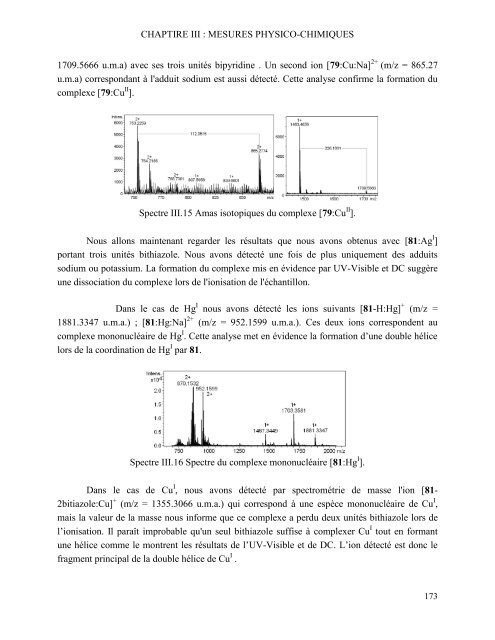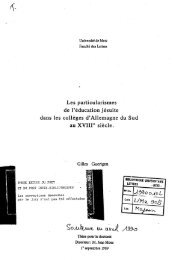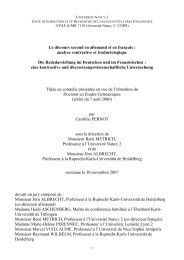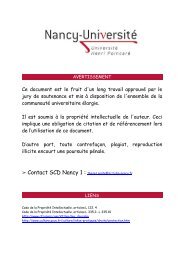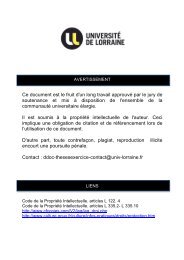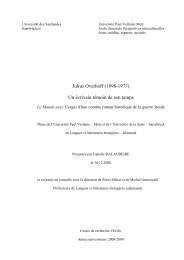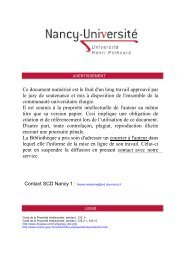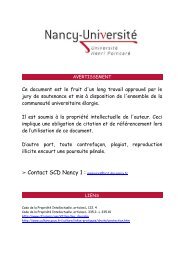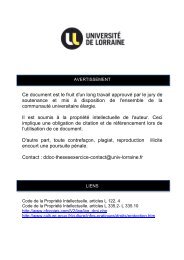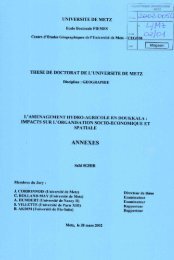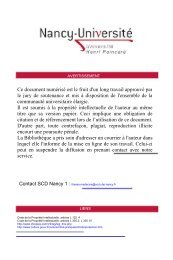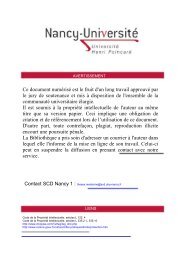Ce document est le fruit d'un long travail approuvé par le jury de ...
Ce document est le fruit d'un long travail approuvé par le jury de ...
Ce document est le fruit d'un long travail approuvé par le jury de ...
You also want an ePaper? Increase the reach of your titles
YUMPU automatically turns print PDFs into web optimized ePapers that Google loves.
CHAPTIRE III : MESURES PHYSICO-CHIMIQUES<br />
1709.5666 u.m.a) avec ses trois unités bipyridine . Un second ion [79:Cu:Na] 2+ (m/z = 865.27<br />
u.m.a) correspondant à l'adduit sodium <strong>est</strong> aussi détecté. <strong>Ce</strong>tte analyse confirme la formation du<br />
comp<strong>le</strong>xe [79:Cu II ].<br />
Spectre III.15 Amas isotopiques du comp<strong>le</strong>xe [79:Cu II ].<br />
Nous allons maintenant regar<strong>de</strong>r <strong>le</strong>s résultats que nous avons obtenus avec [81:Ag I ]<br />
portant trois unités bithiazo<strong>le</strong>. Nous avons détecté une fois <strong>de</strong> plus uniquement <strong>de</strong>s adduits<br />
sodium ou potassium. La formation du comp<strong>le</strong>xe mis en évi<strong>de</strong>nce <strong>par</strong> UV-Visib<strong>le</strong> et DC suggère<br />
une dissociation du comp<strong>le</strong>xe lors <strong>de</strong> l'ionisation <strong>de</strong> l'échantillon.<br />
Dans <strong>le</strong> cas <strong>de</strong> Hg I nous avons détecté <strong>le</strong>s ions suivants [81-H:Hg] + (m/z =<br />
1881.3347 u.m.a.) ; [81:Hg:Na] 2+ (m/z = 952.1599 u.m.a.). <strong>Ce</strong>s <strong>de</strong>ux ions correspon<strong>de</strong>nt au<br />
comp<strong>le</strong>xe mononucléaire <strong>de</strong> Hg I . <strong>Ce</strong>tte analyse met en évi<strong>de</strong>nce la formation d’une doub<strong>le</strong> hélice<br />
lors <strong>de</strong> la coordination <strong>de</strong> Hg I <strong>par</strong> 81.<br />
Spectre III.16 Spectre du comp<strong>le</strong>xe mononucléaire [81:Hg I ].<br />
Dans <strong>le</strong> cas <strong>de</strong> Cu I , nous avons détecté <strong>par</strong> spectrométrie <strong>de</strong> masse l'ion [81-<br />
2bitiazo<strong>le</strong>:Cu] + (m/z = 1355.3066 u.m.a.) qui correspond à une espèce mononucléaire <strong>de</strong> Cu I ,<br />
mais la va<strong>le</strong>ur <strong>de</strong> la masse nous informe que ce comp<strong>le</strong>xe a perdu <strong>de</strong>ux unités bithiazo<strong>le</strong> lors <strong>de</strong><br />
l’ionisation. Il <strong>par</strong>aît improbab<strong>le</strong> qu'un seul bithiazo<strong>le</strong> suffise à comp<strong>le</strong>xer Cu I tout en formant<br />
une hélice comme <strong>le</strong> montrent <strong>le</strong>s résultats <strong>de</strong> l’UV-Visib<strong>le</strong> et <strong>de</strong> DC. L’ion détecté <strong>est</strong> donc <strong>le</strong><br />
fragment principal <strong>de</strong> la doub<strong>le</strong> hélice <strong>de</strong> Cu I .<br />
173


